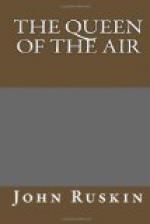In Plate cxv. of vol. ii, Le Normand, are given two sides of a vase, which, in rude and childish ways, assembles most of the principal thoughts regarding Athena in this relation. In the first, the sunrise is represented by the ascending chariot of Apollo, foreshortened; the light is supposed to blind the eyes, and no face of the god is seen (Turner, in the Ulysses and Polyphemus sunrise, loses the form of the god in light, giving the chariot-horses only; rendering in his own manner, after 2,200 years of various fall and revival of the arts, precisely the same thought as the old Greek potter). He ascends out of the sea; but the sea itself has not yet caught the light. In the second design, Athena as the morning breeze, and Hermes as the morning cloud, fly over the sea before the sun. Hermes turns back his head; his face is unseen in the cloud, as Apollo’s in the light; the grotesque appearance of an animal’s face is only the cloud-phantasm modifying a frequent form of the hair of Hermes beneath the back of his cap. Under the morning breeze, the dolphins leap from the rippled sea, and their sides catch the light.
The coins of the Lucanian Heracleia give a fair representation of the helmed Athena, as imagined in later Greek art, with the embossed Scylla.
40. Fourthly, Athena is the air nourishing artificial light—unconsuming fire. Therefore, a lamp was always kept burning in the Erechtheum; and the torch-race belongs chiefly to her festival, of which the meaning is to show the danger of the perishing of the light even by excess of the air that nourishes it; and so that the race is not to the swift, but to the wise. The household use of her constant light is symbolized in the lovely passage in the Odyssey, where Ulysses and his son move the armor while the servants are shut in their chambers, and there is no one to hold the torches for them; but Athena herself, “having a golden lamp,” fills all the rooms with light. Her presence in war-strength with her favorite heroes is always shown by the “unwearied” fire hovering on their helmets and shields; and the image gradually becomes constant and accepted, both for the maintenance of household watchfulness, as in the parable of the ten virgins, or as the symbol of direct inspiration, in the rushing wind and divided flames of Pentecost; but together with this thought of unconsuming and constant fire, there is always mingled in the Greek mind the sense of the consuming by excess, as of the flame by the air, so also of the inspired creature by its own fire (thus, again, “the zeal of thine house hath eaten me up”—“my zeal hath consumed me, because of thine enemies,” and the like); and especially Athena has this aspect towards the truly sensual and bodily strength; so that to Ares, who is himself insane and consuming, the opposite wisdom seems to be insane and consuming: “All we the other gods have thee against us, O Jove! when we would give grace to men; for thou hast begotten the maid without a mind— the mischievous creature, the doer of unseemly evil. All we obey thee, and are ruled by thee. Her only thou wilt not resist in anything she says or does, because thou didst bear her—consuming child as she is.”




